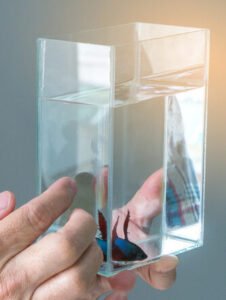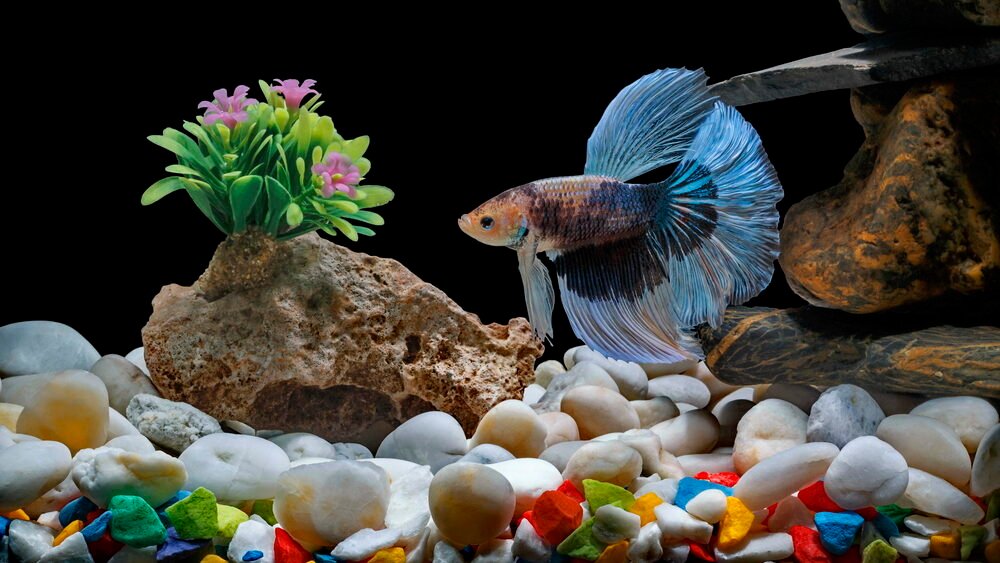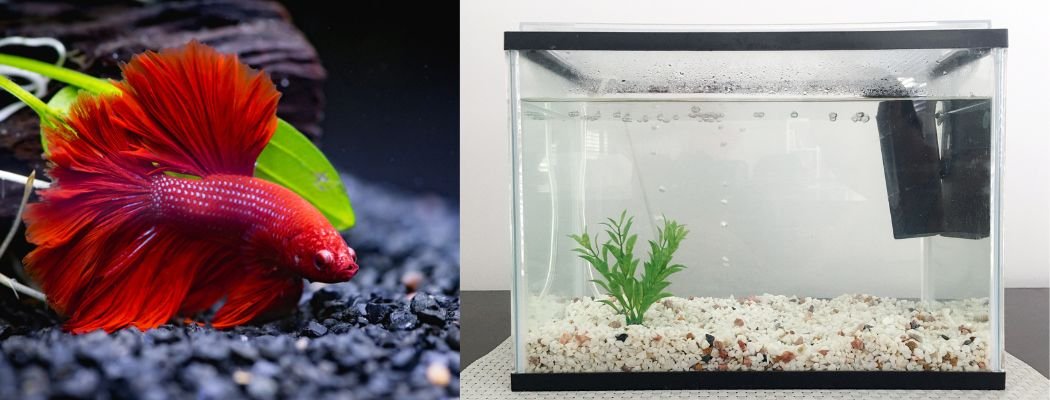What is the Ideal Tank Size for a Betta Fish?
Betta fish, also known as Siamese fighting fish, are a popular tropical aquarium species. These small fish are native to South-East Asia freshwater, so they need the right tank size and water conditions to feel at home. Betta tank size is an essential topic for keeping your fish healthy, so let’s talk about it.
How big should a betta fish tank size be?

Which tank size is best for bettas? The perfect size allows you to recreate the fish’s natural habitat, and there are various things to consider. I would not keep any fish in a tank smaller than 2.5 gallons, but rather a bigger tank of at least 5 gallons, and even more so if adding a few water creatures as tank pals, plants, and building hiding places to create a cozy atmosphere. Some people keep their fish in a fish bowl, which is not big enough. Remember that most fish require swimming space and hiding in light and darkness. A minimum size of 2.5 gallons or a 5-gallon tank size for betta will give them enough room to swim around without feeling cramped.
The benefits of a larger betta tank size are many:
- It creates a better environment.
- You can change the water less often.
- There is more space to decorate the aquarium, add substrate, and more space for accessories or equipment such as air pumps, heaters, and water filters.
A larger space gives you more room to add live plants that produce oxygen and more aquascaping possibilities than a smaller tank.
How to set up a suitable environment for your betta tank

Here is the beginner’s guide to how you set up your fish tank to keep your betta happy:
- Choose the right size tank. Betta fish need at least 2.5 gallons, but ideally, 5 gallons of water to be comfortable.
- Use a filter to clean the water, or you’ll have to change it more often to keep it fresh and clean.
- Add decorations and plenty of places to hide. Your fish needs a place to hide and relax to feel safe. They also love swimming around and exploring places so add some cool stuff there. Living with rocks, plants, leaves, and wood is more splendid and fun than swimming laps in a water glass box. Consider how you would feel trapped in a flat desert with nothing but sand in all directions compared to hiking on a trail through fields, forests, and mountains. Variety is stimulating, and invariability is dull.
- Set the water temperature to 76°F and monitor it to ensure it stays between 72-82°F.
- Check that the pH level is neutral, around 7. If it drops below 6.5 or goes above 8, the water will be either too acidic or too alkaline.
Following these steps will help you create the best betta environment.
Tips for maintaining a healthy aquarium environment for your bettas

Have you ever heard about the two fish swimming together, and one of them says, “the water is nice today,” and the other responds, “what’s water?”
Fish are mainly oblivious to the water they live in when the conditions are good. But suppose the water conditions change for the worse. In that case, they may suddenly realize how important good water is and have no idea how bad it could get until they are suffocating without oxygen in a dirty opaque soup of debris.
You must maintain a healthy aquarium to keep your betta fish happy and healthy. Here are a few tips:
- Changing water often keeps your water quality good. If you don’t do this, the worst-case scenario is dirty water lacking oxygen that makes your fish sick. You don’t want that.
- Nutrition is another critical factor. Every animal needs a good diet. Without proper food, we end up malnourished and have many health problems.
- Avoid overfeeding. Another common mistake is overfeeding, which can make any animal obese and inactive and cause health issues. Balance is vital when it comes to diet.
- Avoid beginner mistakes such as overcrowding your fish tank. Fish are gentle creatures that can easily stress, and they may live in different habitats in terms of water conditions and what tank mates they are comfortable cohabitating with. Introducing two species that are aggressive to each other can cause a small-scale war and end in a bloodbath for your fish. Fish also need time to acclimate to small changes over time. Failing to adjust can cause so much distress that it kills the fish. If you don’t believe me, ask anyone who has tried introducing wild fish to captivity or commercial aquarium. It’s a meticulous process with significant risks; not all fish survive the transition.
- Another common mistake to avoid is to be careless about the items you introduce to the tank or to add low-quality material to your tank, for example, using regular gravel as a substrate on the tank floor. If you are careless, the worst-case scenario is that you add a plant that worsens the water conditions or is harmful to the fish. Do research first.
Any mistake can seriously affect your fish’s health, so address every point carefully. Take the time to learn about proper care and aquarium maintenance, and you will have fish that will love you forever.

